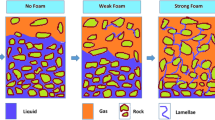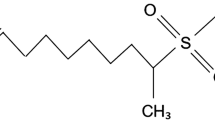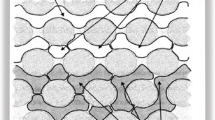Abstract
The foam performance in the presence of oil plays an important role in foam application in enhancing oil recovery. The present study systematically investigated the effect of oil type, oil content, surfactant type, surfactant concentration, alkane chain length, salinity, and polymer concentration on foam performance in both the absence and presence of oil. The results showed that oil viscosity and oil density as well as oil component all contributed to foam performance in the presence of oil. Within a certain oil content, both light oil and heavy oil had a positive effect on foam, but heavy oil had a higher tendency to stabilize the foam. The order of foam performance by different surfactants was changed by the oil. It is noteworthy that heavy oil is detrimental to sodium dibutyl naphthalene sulfonate (BM) foam. Light oil can improve foam performance while heavy oil can harm foam in some specific cases. Lower salinity, longer alkane chain length, higher surfactant concentration and the presence of a polymer all benefited foam in the presence of crude oil.











Similar content being viewed by others
References
Simjoo M, Rezaei T, Andrianov A, Zitha PLJ. Foam stability in the presence of oil: effect of surfactant concentration and oil type. Colloids Surf A. 2013;438:148–58.
Li R, Bleu RBL, Liu S, Hirasaki GJ, Miller CA (2008) Foam Mobility Control for Surfactant EOR. SPE Symposium on Improved Oil Recovery, April 20-23, Tulsa, Oklahoma, USA.
Guo H, Faber MJ, Buijse MA, Zitha PLJ (2011) A novel alkaline-surfactant-foam EOR process. SPE Enhanced Oil Recovery Conference, July 19-21, Kuala Lumpur, Malaysia.
Harkins WD, Feldman A. Films. spreading of liquids and the spreading coefficient. J Am Chem Soc. 1922;44:2665–85.
Aveyard R, Binks BP, Fletcher PDI, Peck TG, Rutherford CE. Aspects of aqueous foam stability in the presence of hydrocarbon oils and solid particles. Adv Coll Interface Sci. 1994;48:93–120.
Schramm LL, Novosad JJ. Micro-visualization of foam interactions with a crude oil. Colloids Surf. 1990;46:21–43.
Schramm LL, Novosad JJ. The destabilization of foams for improved oil recovery by crude oils: effect of the nature of the oil. J Petrol Sci Eng. 1992;7:77–90.
Vikingstad AK, Skauge A, Høiland H, Aarra M. Foam–oil interactions analyzed by static foam tests. Colloids Surf A. 2005;260:189–98.
Lee J, Nikolov A, Wasan D. Stability of aqueous foams in the presence of oil: on the importance of dispersed vs solubilized oil. Ind Eng Chem Res. 2012;52:66–72.
Lee J, Nikolov A, Wasan D. Effects of micellar structuring and solubilized oil on the kinetic stability of aqueous foams. Ind Eng Chem Res. 2014;53:18891–9.
Rohani MR, Ghotbi C, Badakhshan A. Foam stability and foam–oil interactions. Pet Sci Technol. 2014;32:1843–50.
Mannhardt K, Novosad JJ, Schramm LL (1998) Foam/oil interations at reservoir conditions. SPE/DOE Improved Oil Recovery Symposium, April 19–22, Tulsa, Oklahoma.
Sun L, Pu W, Xin J, Wei P, Wang B, Li Y, Yuan C. High temperature and oil tolerance of surfactant foam/polymer–surfactant foam. Rsc Advances. 2015;5:23410–8.
Manlowe DJ, Radke CJ. A pore-level investigation of foam/oil interactions in porous media. Spe Reservoir Engineering. 1990;5:495–502.
Farajzadeh R, Andrianov A, Krastev R, Hirasaki GJ, Rossen WR. Foam–oil interaction in porous media: implications for foam assisted enhanced oil recovery. Adv Coll Interface Sci. 2012;183:1–13.
Novosad JJ, Mannhardt K (1989) The interaction between foam and crude oils. Annual Technical Meeting. Annual Technical Meeting, May 28–31, Banff.
Jensen JA, Friedmann F (1987) Physical and chemical effects of an oil phase on the propagation of foam in porous media. SPE California Regional Meeting, April 8–10, Ventura, California.
Osei-Bonsu K, Shokri N, Grassia P. Foam stability in the presence and absence of hydrocarbons: from bubble- to bulk-scale. Colloids Surf A. 2015;43:514–26.
Kuhlman MI. Visualizing the effect of light oil on CO2 foams. J Petrol Technol. 1990;42:902–8.
Zhu T, Ogbe DO, Khataniar S. Improving the foam performance for mobility control and improved sweep efficiency in gas flooding. Ind Eng Chem Res. 2004;43:4413–21.
Nikolov AD, Wasan DT, Huang DW, Edwards DA (1986) The effect of oil on foam stability: mechanisms and implications for oil displacement by foam in porous media. SPE Annual Technical Conference and Exhibition, October 5-8, New Orleans, Louisiana.
Duan X, Hou J, Cheng T, Li S, Ma Y. Evaluation of oil-tolerant foam for enhanced oil recovery: laboratory study of a system of oil-tolerant foaming agents. J Petrol Sci Eng. 2014;122:428–38.
Jian G, Hou Q, Zhu Y. Stability of polymer and surfactant mixture enhanced foams in the presence of oil under static and dynamic conditions. J Dispersion Sci Technol. 2015;36:477–88.
Pang SS, Pu WF, Li YY, Liu ZZ, Wang CY, Liu YF. Influence factors on the stability of foam–oil interaction. Oilfield Chem. 2015;32:355–9.
Jin FY, Wang S, Pu WF, Yuan CD, Wang L, Li KX, Gong C. Emulsified oil foam for improving the flowability of heavy oil in wellbore under high salinity environments. J Ind Eng Chem. 2016;39:153–61.
Aveyard R, Binks BP, Fletcher PDI, Peck TG, Garrett PR. Entry and spreading of alkane drops at the air/surfactant solution interface in relation to foam and soap film stability. J Chem Soc, Faraday Trans. 1993;89:4313–21.
Andrianov A, Farajzadeh R, Nick MM, Talanana M, Zitha PLJ. Immiscible foam for enhancing oil recovery: bulk and porous media experiments. J Ind Eng Chem. 2012;51(5):2214–26.
Lobo LA, Nikolov AD, Wasan DT. Foam stability in the presence of oil: on the importance of the second virial coefficient. J Dispersion Sci Technol. 1989;10:143–61.
Vikingstad AK, Aarra MG, Skauge A. Effect of surfactant structure on foam–oil interactions: comparing fluorinated surfactant and alpha olefin sulfonate in static foam tests. Colloids Surf A. 2006;279:105–12.
Myers D. Surfactant science and technology. 3rd ed. Hoboken: Wiley; 2005.
Bergeron V, Radke CJ. Disjoining pressure and stratification in asymmetric thin-liquid films. Colloid Polym Sci. 1995;273:165–74.
Aronson AS, Bergeron V, Fagan ME, Radke CJ. The influence of disjoining pressure on foam stability and flow in porous media. Colloids Surf A. 1993;83:109–20.
Behera MR, Varade SR, Ghosh P, Paul P, Negi AS. Foaming in micellar solutions: effects of surfactant, salt, and oil concentrations. Ind Eng Chem Res. 2014;53:18497–507.
Acknowledgements
The authors are grateful to the support received from the State Key Laboratory of Oil and Gas Reservoir Geology and Exploitation, Southwest Petroleum University.
Author information
Authors and Affiliations
Corresponding author
About this article
Cite this article
Pu, W., Pang, S. & Wang, C. Experimental investigation of foam performance in the presence of crude oil. J Surfact Deterg 20, 1051–1059 (2017). https://doi.org/10.1007/s11743-017-1991-3
Received:
Accepted:
Published:
Issue Date:
DOI: https://doi.org/10.1007/s11743-017-1991-3




